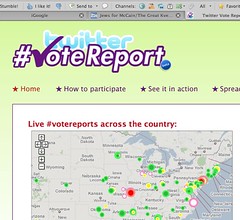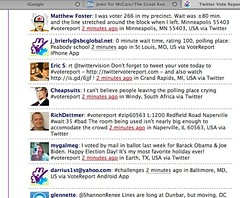This post is party-neutral, but 100% American. Here is an example that DeTocqueville would have been happy to report on, had he lived several hundred years. 
Twitter Vote Report has enabled people to directly report on their voting experience, including if they had issues with machines, polling places, how long the line is.
Look at the Americans, from all over the country, letting people know that they have voted, and more importantly, pointing out the flaws so they can be quickly fixed to ensure fair elections. I’ll be Twittering my vote report today.
Twitter Vote Report » Spread the word
On November 4th 2008, millions of Americans will go to over 200,000 distinct voting locations and using different systems and machinery to vote. Some voters will have a terrific experiences, and others will experience the same problems we have been hearing about for years – long lines, broken machines, inaccurate voting rolls, and others will experience problems that we haven’t heard about before. That’s why a new citizen-driven election monitoring system called Twitter Vote Report (www.twittervotereport.com) was just launched. Using either Twitter.com, iPhone, direct SMS, or our telephone hotlines, voters will have a new way to share their experiences with one another and ensure that the media and watchdog groups are aware of any problems.
And YOU can help! Be a citizen journalist! Submit a report about conditions at your polling place.
Clients sometimes ask what value Social Media brings to our society. This is a great example of collective, mostly de-centralized action for a cause. Imagine what your company could do for its customers if some percentage of them had a reason to care this much about something.


Yeah, the Twitter Vote Report is a pretty cool way of aggregating the election day twitter data. I’ve been working on a similar project Freshly Squeezed Tweets. It aggregates tweets like Twitter Vote Report, but it creates a more abstract visualization of the aggregate conversation on Twitter showing frequency and context of election-related words. The site will pull a continuous stream of tweets mentioning Obama and McCain, representing the most-used terms as a series of bubbles. The bigger the “bubble” the more frequently the term is being used. You can hover over each word to see a graphical breakdown of each word’s use.